Introduction
In the business world, customer satisfaction is a key factor. Beyond satisfaction, certain sectors must adhere to very strict standards to ensure that the products sold do not have a harmful impact on consumer health. Therefore, it is essential to establish rigorous quality controls to ensure that products meet standards and the high expectations of the markets. These controls help detect defects before products reach consumers, thereby reducing returns, claims, and reputation losses.
Performing quality controls within an Enterprise Resource Planning (ERP) system allows for centralizing data. This centralization facilitates tracking and management across the organization, optimizing decision-making. Furthermore, automating and standardizing quality control processes enhances operator productivity and reduces costs associated with defects and non-conformities.
In summary, ensuring quality tracking through an ERP system guarantees the competitiveness and longevity of the company, while maintaining high product quality and optimal customer satisfaction.
Quality controls with Odoo
In Odoo, you have the ability to configure checkpoints. A checkpoint monitors a type of logistical operation and applies to a list of items.
Voici à quoi peut ressembler un point de contrôle.
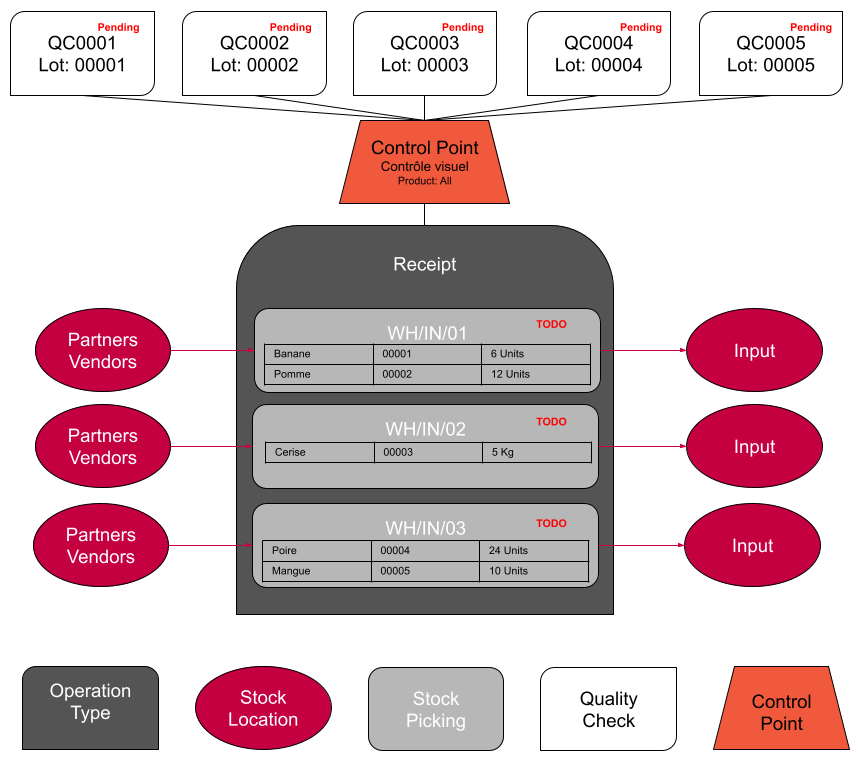
In this example, we have a checkpoint monitoring receiving operations with three planned receipts: WH/IN/01, WH/IN/02, and WH/IN/03. This checkpoint applies to all items, meaning a visual inspection quality check is generated for each incoming item. No item can be received without its visual inspection being validated.
Thus, the 6 bananas in our example cannot be received until their quality control QC0001 has been validated.
It is important to note that a checkpoint can monitor different types of logistical movements: receipts, deliveries, internal transfers, productions, etc.
Each checkpoint can also be associated with a frequency, with three possible levels:
- All the time: Every logistical movement triggers a quality control.
- Periodically: You can specify a time frequency, such as 1 month. In this case, Odoo will create a quality control only if one month has passed since the last control.
- Randomly: You can specify a percentage, for example 20%. Odoo will then perform quality controls randomly on 20% of the logistical movements.
Additionally, each checkpoint has a type. The main types are as follows:
- Take a photo: Requires the user to take a photo of the moved item.
- Pass / Fail: Allows the user to indicate whether the control passed or failed.
- Measurement: Allows the user to indicate a numeric value as well as an acceptance range. All measurements within the range will be considered as passing.
Although standard checkpoints offer other features, these are less important. Odoo's standard functionality remains quite simplistic when it comes to quality management.
Certain major limitations should be noted:
- Logistical transfers are blocked until quality controls are completed. If the quality and logistics teams are separate, the work of one team can hinder the other.
- It is not possible to input more than one measurement per control.
- It is not possible to generate quality controls for samples.
- It is not possible to schedule controls.
- There is no precise audit trail that allows easy tracking of who modified which data and when.
- It is not possible to generate certificates of conformity.
Batch Status
What is a batch status?
Our solution Smart Quality ntroduce batch statuses. These determine the quality level of a batch. The batch quality level determines where it can be stored.
A batch entering our stock for the first time is automatically assigned a default batch status of 'Unrestricted'. 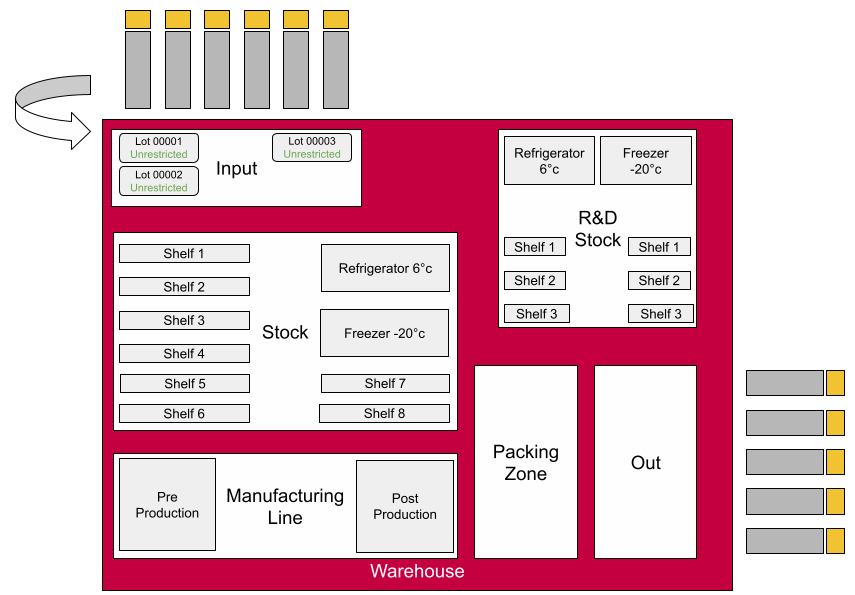
This status will then be modified by any quality controls generated by the system.
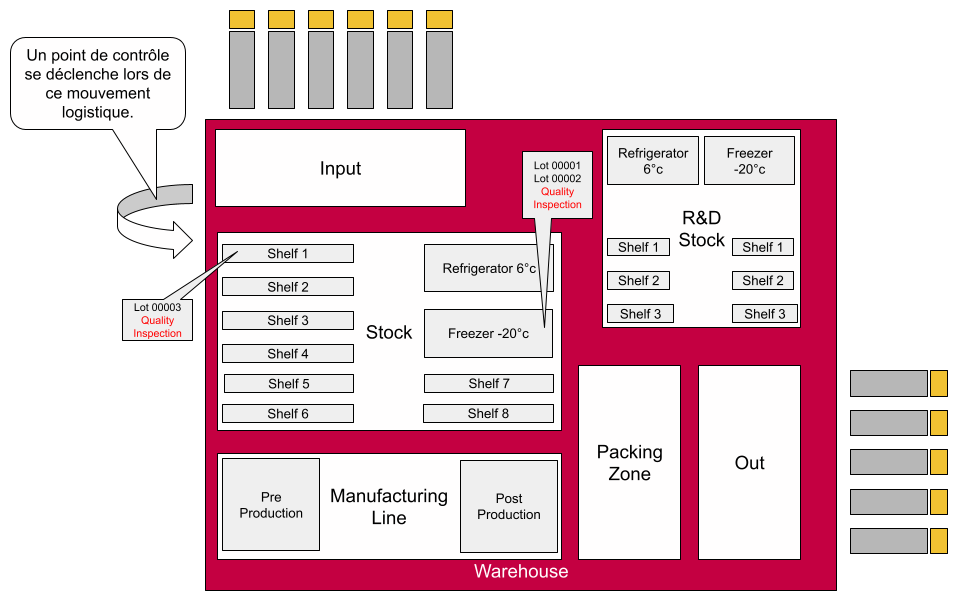
In our example above, batches 00001, 00002, and 00003 were moved from the Input zone to Stock. During this logistical move, a checkpoint triggered quality control for each batch. The quality controls updated the batch statuses from "Unrestricted" to "Quality Inspection".
Depending on the results of the quality controls, the batch statuses will be updated again.
Here are the batch statuses automatically created by Smart Quality. These can be modified, and it's also possible to add more.
- Unrestricted
- Quality Inspection
- Released
- Blocked
- Closed
- Sample
Each of these batch statuses can be associated with a list of unauthorized zones. Here's an example of how this configuration could be set up.
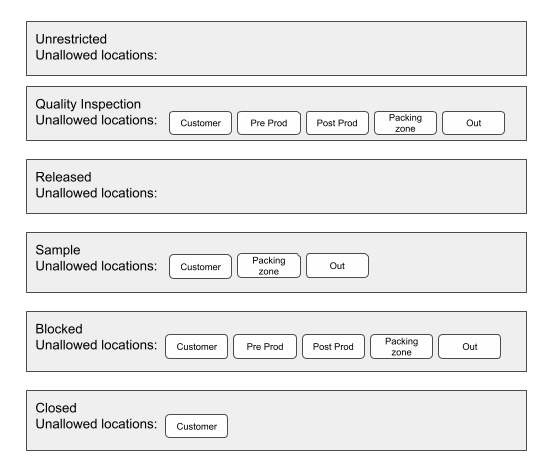
Following this configuration, a batch in the "Quality Inspection" status does not have access to delivery and production zones. However, it could be used in all stock and R&D zones.
What are the benefits of batch statuses?
The most obvious advantage is that a batch is no longer blocked to a specific location due to pending quality control. In our example from earlier, bananas, apples, cherries, pears, and mangoes cannot be received because a quality control has been triggered.
With batch statuses, logistics operators can receive batches but cannot store them anywhere they choose. Instead of being blocked to a specific location, batches are now limited to a zone within your warehouse depending on their status.
Another advantage is that batch statuses facilitate easier reporting and stock analysis. It's straightforward to sort batches based on their status and check their location.
They also allow batches to be used before their quality control has been completed, especially for research and development purposes.
Generating quality controls on demand.
In the standard Odoo setup, you must create a logistic movement request for a checkpoint to trigger and generate a quality control, which is not always convenient. You might want to generate a quality control on demand instead.
Imagine a refrigerator breaks down overnight; you would likely want to test the quality of all the products stored inside. Smart Quality allows you to do this easily. Simply go to the lot record where a button triggers a specific checkpoint.
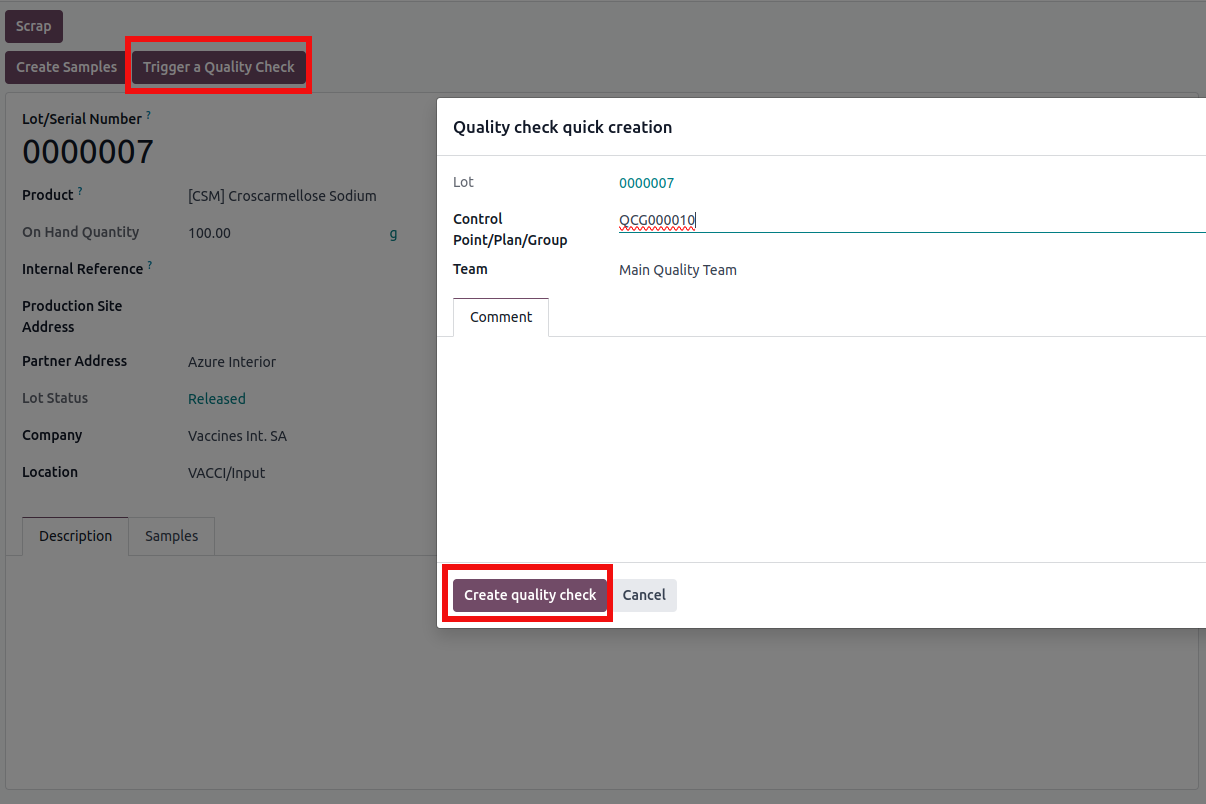
By validating the pop-up, Odoo will generate quality controls linked to the selected checkpoint. This action will simultaneously update the lot status to 'Quality Inspection'.
This feature gives you more flexibility. You can trigger any control on any lot whenever you want.
Groups and control plans
Why did we have to add these concepts to the Odoo system?
Imagine the following scenario:
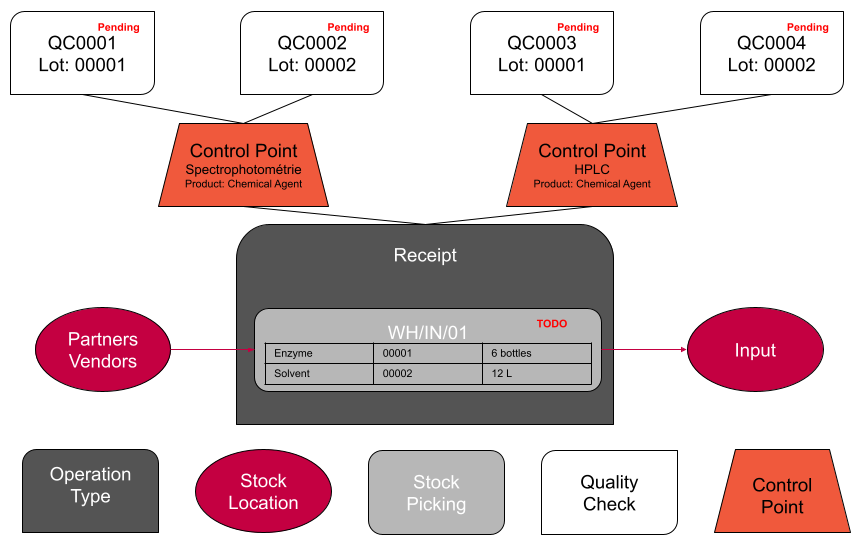
We have two control points that both monitor receipts and both apply to chemical agents. When we receive a batch of enzyme and a batch of solvent, the two control points are triggered and each creates a quality control per batch.
This scenario is perfectly possible in the Odoo standard, but it is problematic with the notion of batch status. Who is responsible for updating the batch status? Spectrophotometry or high-performance liquid chromatography?
Our two batches 00001 and 00002 both have quality inspections pending, and their batch status is "Quality Inspection". So far, so good. But when the time came for spectrophotometry, the quality team carried out the tests and came back with conclusive results. They encode their results in the Odoo system and certify that the QC0001 and QC0002 quality controls have been passed.
Now that the quality controls have been validated, the system should update the status of batches 00001 and 00002 to "Released", but QC0003 and QC0004 are still pending. What do we do now?
This is where the control groups and plans come into play.
Smart Quality introduces 2 additional control levels. We therefore have 3 control levels.
- Control points: The lowest level of control.
- Control plans: Allows several control points to be grouped together.
- Control groups: The highest control level, used to group together several control plans.
The highest control level is responsible for the batch status.
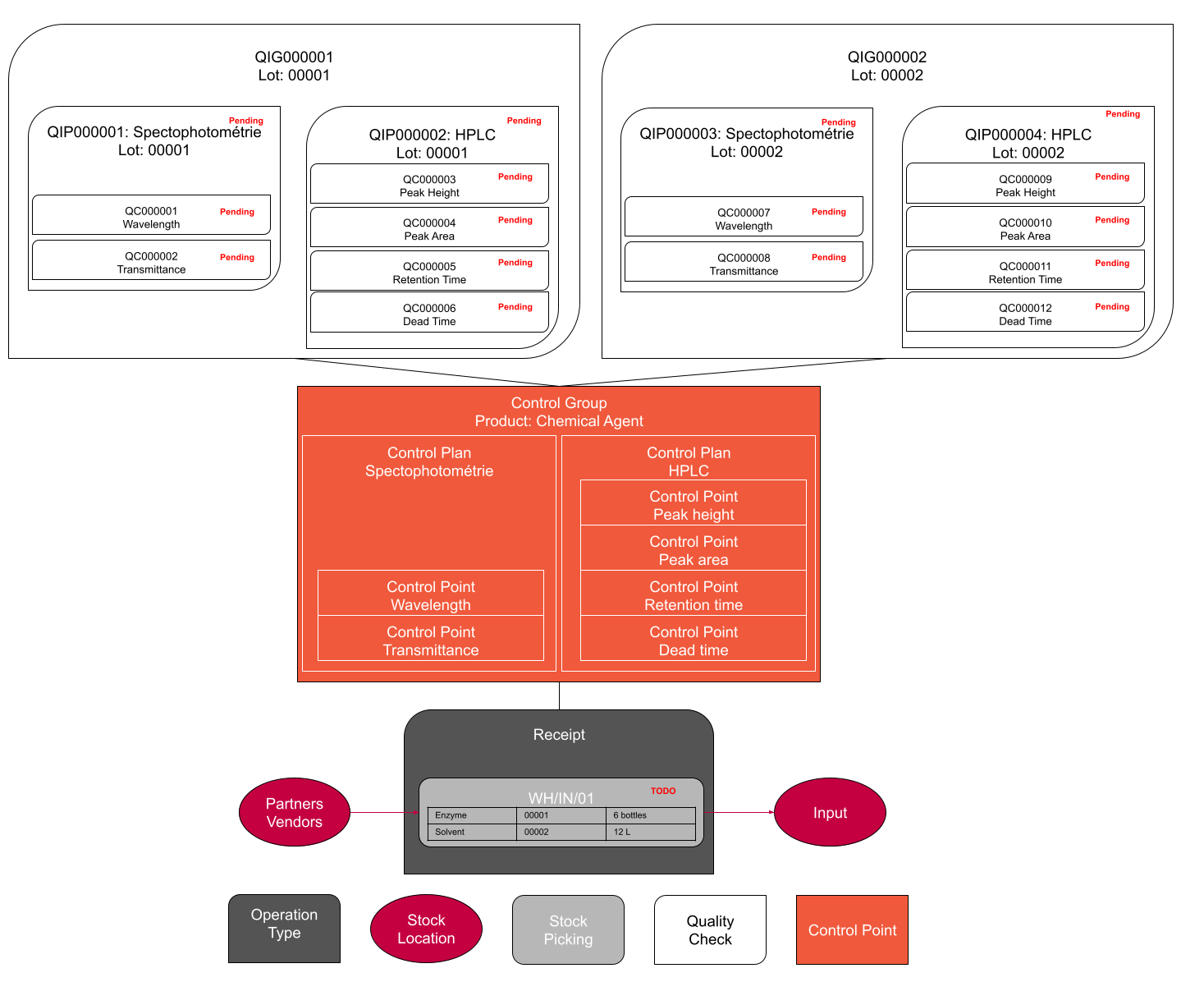
In the example above, we have a group control that monitors receipts and applies to all chemical agents.
Our group control has created 4 inspection plans (QIP000001 -> QIP000004). An inspection plan is a Pass/Fail quality control with child quality controls. An inspection plan cannot be closed until its child quality checks have been carried out. For example, the wavelength and transmittance measurements need to be encoded before the QIP000001 inspection plan can be validated or not.
Inspection plans QIP000001 and QIP000002 are part of the same inspection group QIG000001. An inspection group is automatically validated when all its inspection plans have been completed. The success or failure of a group depends on the success or failure of its plans.
An inspection group is successful if all its plans are successful, otherwise it fails.
Only when inspection group QIG000001 is closed is the status of batch 00001 updated according to its success or failure.
Quality control constraints
However, these concepts introduce constraints into the creation of control points, plans and groups, as well as the creation of quality controls.
Firstly, we cannot have two independent controls in the system which apply to the same items and which monitor the same type of operation.
For example, the following case is not possible because we are trying to configure two independent controls that both monitor the same type of operation and apply to the same item "Enzyme", enzymes being chemical agents.
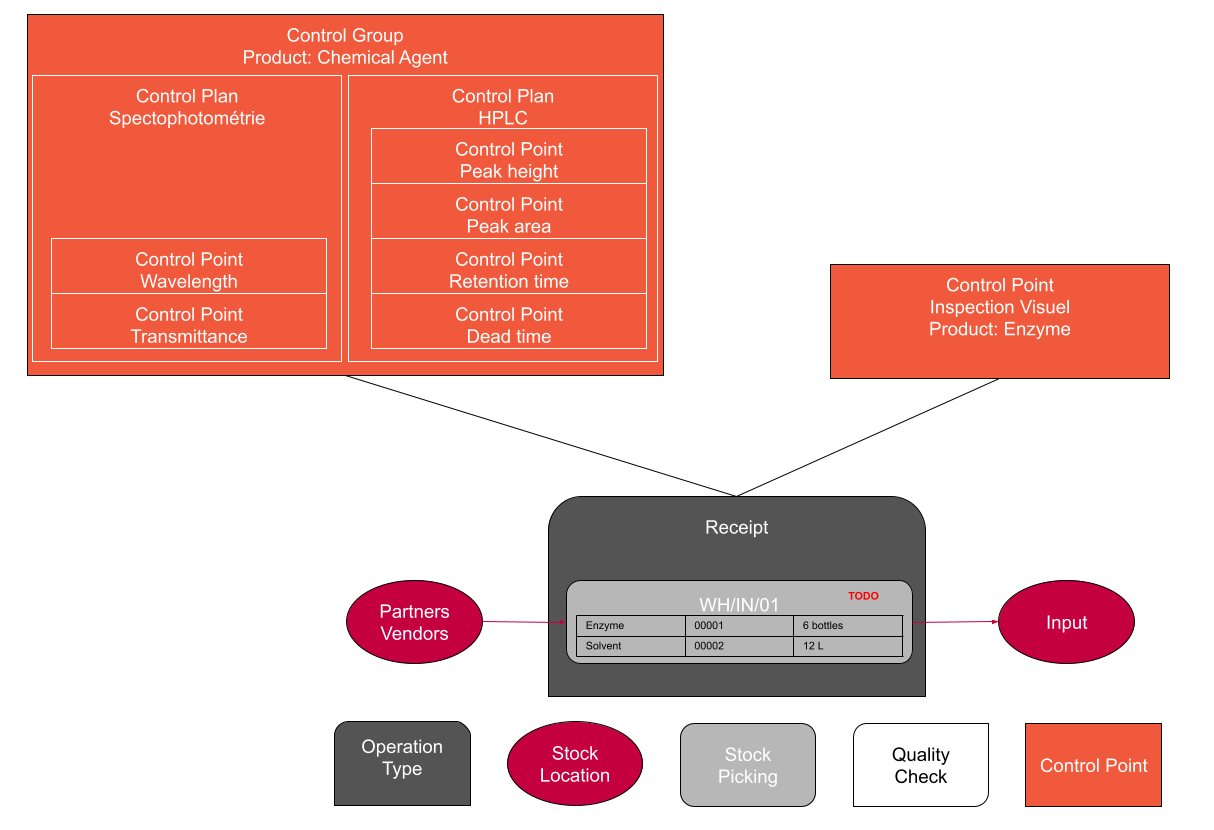
Secondly, we can't have two independent quality checks going on at the same time. Let's take the following warehouse as an example:
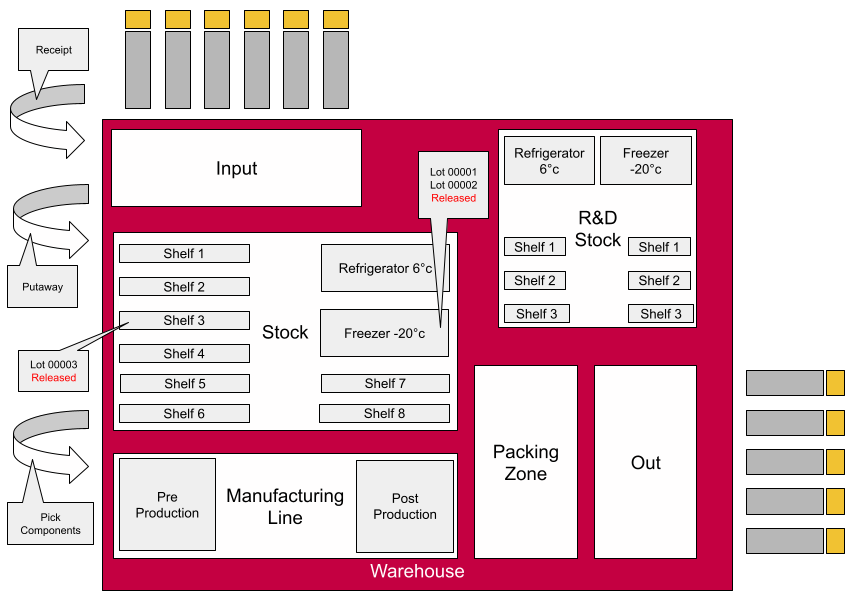
This warehouse belongs to a car manufacturing company. It has several types of logistics operation, including Receipt, Putaway and Pick Components. The company buys metal coils for use on its production lines. The quality of these coils is checked at two different stages: on receipt, the dimensions are checked. Then, before being used in production, the properties of the coil are tested, such as hardness and surface finish.
To reflect this flow in Odoo, we set up two control points. One that monitors receipts (Receipt) and another that monitors the selection of components (Pick Components).
When the logistics operators perform the reception in the software, it generates quality controls to check the dimensions of each reel.
Then, when the reels are sent to production, Odoo generates a second quality check to verify hardness and surface finish. This operation is not authorised until the first check has been carried out.
The software will not tolerate two pending quality checks linked to different logistical operations.
The benefits of control plans and groups.
Control groups and plans allow you to group together the controls to be performed, making configuration easier and giving users better visibility.
They also increase security, by allowing you to differentiate between the people responsible for validating controls, plans and groups.
You can restrict access to groups and plans to certain security levels. The quality status of batches is only adjusted when the highest level is validated, preventing unauthorised people from releasing batches.
Measurement encoding is also greatly improved. It is much easier to encode a large number of measurements with our solution than with the Odoo standard.
Conclusion
The importance of maintaining high product quality cannot be underestimated, particularly in sectors where compliance with regulatory standards is crucial to consumer safety. Integrating quality controls into an ERP system such as Odoo enables data to be centralised and processes to be automated, improving operational efficiency and reducing the costs associated with defects and non-conformities. Odoo's checkpoint functionality, while effective, has certain limitations, notably the inability to manage checks on samples or generate certificates of conformity.
The Smart Quality solution introduces additional functionality such as batch status and control groups, providing greater flexibility and accuracy.
In short, implementing rigorous quality controls and monitoring them within an ERP system, enhanced by functionalities such as those offered by Smart Quality, improves companies' competitiveness. This helps maintain high product quality and customer satisfaction.
To find out more about the solution, visit our product page.
Vous souhaitez en savoir plus?
Part 2 : Sampling présentation.
We organise free online demo sessions every month, so don't hesitate to sign up!
Any questions ?
If you have any questions, please don't hesitate to contact us. Our teams will be delighted to answer them.
Advanced Quality Control within Smart Biotech: Part I